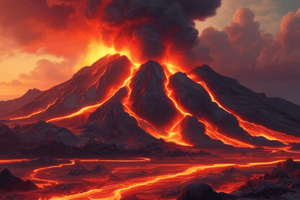Podcast
Questions and Answers
What is the primary source of internal heat in the Earth’s mantle associated with the decay of isotopes?
What is the primary source of internal heat in the Earth’s mantle associated with the decay of isotopes?
- Geothermal heat
- Primordial heat
- Radiogenic heat (correct)
- Solar heat
Which process is primarily responsible for the transfer of heat in the mantle?
Which process is primarily responsible for the transfer of heat in the mantle?
- Conduction
- Subduction
- Radiation
- Convection (correct)
In Bowen's Reaction Series, which type of magma is typically formed at higher temperatures?
In Bowen's Reaction Series, which type of magma is typically formed at higher temperatures?
- Mafic magma (correct)
- Felsic magma
- Ultramafic magma
- Intermediate magma
What is the main consequence of mantle convection on plate tectonics?
What is the main consequence of mantle convection on plate tectonics?
What primarily causes volcanic eruptions in relation to magma?
What primarily causes volcanic eruptions in relation to magma?
What describes the geothermal gradient?
What describes the geothermal gradient?
Which type of magma typically has the lowest viscosity?
Which type of magma typically has the lowest viscosity?
What contributes to the temperature gradient being much lower in the mantle compared to the lithosphere?
What contributes to the temperature gradient being much lower in the mantle compared to the lithosphere?
What is the main cause of magma formation beneath a volcano?
What is the main cause of magma formation beneath a volcano?
What type of magma is primarily formed at subduction zones?
What type of magma is primarily formed at subduction zones?
Which of the following correctly describes the geothermal gradient?
Which of the following correctly describes the geothermal gradient?
What is a common outcome of a volcanic eruption besides gas emissions?
What is a common outcome of a volcanic eruption besides gas emissions?
Which heat transfer mechanism occurs within Earth's mantle?
Which heat transfer mechanism occurs within Earth's mantle?
In Bowen's Reaction Series, what type of rock is formed from low-temperature magma?
In Bowen's Reaction Series, what type of rock is formed from low-temperature magma?
What is one effect of mantle convection on Earth's surface?
What is one effect of mantle convection on Earth's surface?
What happens to heat trapped within the Earth over time?
What happens to heat trapped within the Earth over time?
What is decompression melting primarily caused by?
What is decompression melting primarily caused by?
What does the Bowen's Reaction Series illustrate?
What does the Bowen's Reaction Series illustrate?
What occurs during partial melting?
What occurs during partial melting?
How does fluid-induced melting occur?
How does fluid-induced melting occur?
What describes the temperature of the geothermal gradient in relation to rising rock?
What describes the temperature of the geothermal gradient in relation to rising rock?
What are the characteristics of magma formed at mid-ocean ridges?
What are the characteristics of magma formed at mid-ocean ridges?
Which statement is true about the solidus boundary in magma?
Which statement is true about the solidus boundary in magma?
What effect do hydrated minerals have during subduction?
What effect do hydrated minerals have during subduction?
Flashcards are hidden until you start studying
Study Notes
Magma Formation and Behavior
- Magma's flow is influenced by temperature and mineral content.
- Three primary methods for creating molten magma:
- Decompression melting, caused by decreased pressure.
- Flux melting, resulting from the introduction of volatiles.
- Heat-induced melting, achieved by raising temperature.
Bowen's Reaction Series
- Minerals melt at varying temperatures; the solidus boundary is not a strict line.
- Partial melting occurs as not all minerals in magma fully melt, resulting in a mix of solid, liquid, and volatile components.
Decompression Melting
- Happens at mid-ocean ridges through the ascent of the solid asthenosphere.
- Solid material at higher temperatures rises towards the surface, lowering pressure and initiating melting.
Fluid-Induced Melting
- Occurs in island arcs and subduction zones with the addition of volatiles from subducting slabs.
- Subducting oceanic lithosphere releases hydrated minerals that emit water vapor and other gases as they descend, triggering melting.
Heat Transfer
- Heat transfers from hot to cooler areas via conduction, convection, and radiation.
- Mantle convection: essential for plate tectonics, transports heat from the core to the surface at rates of centimeters per year.
- Convection involves the rising of hot, less dense material, while cooler, denser material descends.
Temperature Gradients
- Describes the change in temperature across a distance.
- Example: A temperature difference from 75°F to 50°F across a region reflects a specific gradient.
Internal Heat Sources
- Composed of:
- Radiogenic heat from isotopes in the mantle and crust.
- Primordial heat, accumulated from the planet's formation.
- Energy from accretion and radioactive decay which involves the breakdown of radioactive elements over time.
Impact of Convection on Plate Tectonics
- Active mantle convection is crucial to maintaining a weak asthenosphere, allowing tectonic movements.
- Stopping of mantle convection could lead to the cessation of tectonic activity, as observed in smaller celestial bodies.
Recent Volcanic Activity
- Taal Volcano erupted on January 12, 2020, releasing both gases and magma along with ash and dust particles, highlighting the processes occurring beneath volcanic regions.
Studying That Suits You
Use AI to generate personalized quizzes and flashcards to suit your learning preferences.




